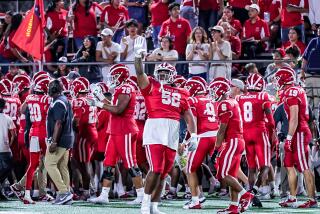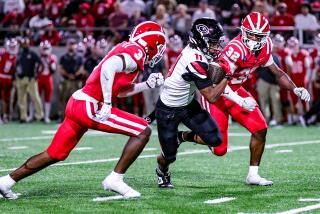Carrying a hefty amount of risk
When the football team from Santa Ana Mater Dei High lined up four weeks ago against Long Beach Poly in a playoff game, its offensive line averaged 282 pounds -- 24 pounds more per man than the five linemen who started for the 1972 Miami Dolphins, the only undefeated team in NFL history.
That same night on another field, Lakewood Mayfair’s right tackle, Rick Chapin, was busy protecting his quarterback from West Covina’s defenders. Chapin stands 6 feet 3 and weighs 280 pounds -- 100 pounds less than he weighed last season.
Yet Chapin, despite his leaner physique, newfound mobility and increased self-esteem, remains clinically obese. At 280 pounds, he would have to be 7 feet 5 inches tall to be in the “normal” range of the body mass index, or BMI, a ratio calculated using weight and height.
Bigger has long been considered better on the football field, especially among linemen, who dole out and absorb hits as blockers and tacklers. But health experts worry about what happens at the end of the athletes’ playing days. Unless they commit to a lifestyle of nutrition and exercise, all that muscle could turn to fat -- and the fat could turn into trouble.
“The obesity epidemic is very real,” said Eric Coris, a team physician at the University of South Florida who is doing research on a pill that measures the core temperature of athletes and has proved that bigger athletes run hotter.
“On the football field, it’s significant,” Coris said. “More significant are the ones who aren’t on the field. The blue-chip guys who we assume are in shape, even those guys are at risk” -- of hypertension, high cholesterol, diabetes, stroke and heart attack.
“The No. 1 cause of death in the U.S. is cardiac, and that’s where a lot of these problems lead. The end damage is blood vessels and heart.”
To bulk up, many high school athletes rely on high-protein, high-carbohydrate diets, and with the addition of weightlifting and cardiovascular conditioning, some become stars with college scholarships within their reach.
But the majority of high school athletes don’t compete at the college level, and only a small percentage continue on to the professional ranks.
“Most of our kids don’t go on to play pro, but we see them come back three or four years later,” said Sandra Fowkes Godek, a researcher at West Chester University in Pennsylvania. “They played at 280 and come back at 320. Kids are 25, 28 years old and are a heart attack waiting to happen.
“That kid who’s 6-3, 240, needs to either lose the weight when he stops playing or needs to continue to lift and exercise like he did when he played football.
“It’s really a change in lifestyle. That’s where education of players and parents comes in. They might be able to get away with it when they’re 18, but when they’re 38, that’s going to be a problem.”
There’s little doubt Americans are carrying more weight than ever. According to the national Centers for Disease Control and Prevention, the average American adult weighs 25 pounds more than in 1960, and obesity among children has quadrupled in the last 25 years.
A person is considered obese if his body mass index is 30 or higher. It’s calculated by multiplying one’s weight by 703, then dividing by one’s height in inches, and dividing again by height in inches.
Using that equation, the Southland is full of obese football players.
In the Los Angeles City Section championship game Friday, for example, only one starting offensive lineman, from Birmingham High, weighed less than 258 pounds. The San Pedro line averaged 6-1 and 278 pounds.
An examination of the rosters of the 365 local teams that appear on maxpreps.com, a website devoted to high school sports, found more than 6,200 players weighing 200 pounds or more, including 234 at 300 pounds or more and two at 400 pounds. The average number of players weighing 200 pounds for each team was 17.
Fowkes Godek said football was a natural outlet for an obese teenager trying to fit in.
“Football is the only sport you can play if you’re a fat kid,” she said. “It does give you a sense of belonging. Kids fit in because they’re on a team and contribute.”
After high school, as the stakes get higher, there seemingly is an even greater emphasis placed on size.
“The colleges want bigger guys, more athletic, and kids are trying to meet the market,” said Jim Clover, author of “Sports Medicine Essentials.”
Clover also is the coordinator of the Sports Physiology Orthopedic Rehabilitation Treatment Clinic in Riverside, which provides 17 trainers to about three dozen high schools in the Inland Empire.
“As soon as they stop working out, that’s where the risk is. All these kids are indestructible right now, but no one is educating them in lifetime conditioning skills. Chasing your target heart rate is different than chasing a football.”
Chris Carlisle, USC’s strength and conditioning coach, said the bigger-is-better mantra was a myth.
“You have to have the frame to put the commensurate size with the position you’re going to play,” he said, “but athleticism is the first key we look at.”
Carlisle pointed to Trojans lineman Sam Baker, who was recruited out of Tustin High at 6-5 and 285 pounds. When Baker showed up on campus in 2003, he weighed 330.
“Somebody got in his ear that you have to be bigger to play at the college level,” Carlisle said, “and that couldn’t be further from the truth.”
After a year of training and practice without playing in a game or using a season of eligibility, Baker played at 290 in 2004 and was a freshman All-American.
Coach Jim Kunau’s Orange Lutheran team won the Southland’s premier championship in the Southern Section Pac-5 Division and will be playing for a state title Saturday.
“From a performance standpoint, most coaches would prefer faster over bigger,” Kunau said. “From a health standpoint, you want kids who can endure a competitive and rigorous practice and not just survive it but thrive in it.”
Said Mater Dei Coach Bruce Rollinson, “I don’t know of a coach who tells a 275-pound kid to gain more weight. We’re pushing these kids to get stronger, not bigger.”
The players who do want to put on weight, he said, are “your younger kids, and your juniors and seniors at the skill positions” such as running backs and receivers “who think it’s better to be 180 than 160.”
Although steroid use is often associated with rapid weight gain and muscle development, particularly in teenagers playing sports or trying to fit in socially at the gym, experts say it’s not usually a factor in contributing to obesity.
High-fat diets and lack of exercise are the most often-cited culprits. And even though high school athletes avoid the latter problem through training, their busy schedules routinely include plenty of stops at fast-food establishments.
That’s why, experts say, it’s important for former athletes to adjust their diets as their commitment to physical training wanes.
“They have the same eating habits and significantly decreased exercise patterns,” said Dr. Jeff Konin, executive director of the SMART Institute at South Florida, which helps provide athletic trainers to Tampa-area high schools.
Former athletes are not only at risk from cardiovascular disease, Konin said, but also from arthritis and other orthopedic ailments because of increased and year-round participation in sports at a younger age.
And not just among men.
“Females are not excluded,” Konin said. “We’re seeing bigger, faster females. We’re going to see a similar epidemic among females whose athletic careers are over and will have the same challenges with their physiology.”
As for Chapin, the Mayfair High lineman who shed 100 pounds, he has taken a healthy step. Since the end of the 2005 season, he has joined his school’s wrestling team, changed his eating habits and exercised consistently.
He is no longer “a big ol’ giant tank,” said his coach, Mike Fitch. “Now he’s a pickup truck with a 350 engine and four-wheel drive.”
Although football might have put a player such as Chapin at his greatest risk, it might also be the thing that saves him in the short term. Would he have lost the weight if he weren’t playing?
“Probably not,” he said. “I’d do anything for football.”
*
(BEGIN TEXT OF INFOBOX)
Heavy hitters
The five-man offensive line for this year’s Santa Ana Mater Dei High football team outweighs the 1972 Miami Dolphins’ offensive line by 118 pounds. Here is the position-by-position breakdown by height and weight:
2006 Mater Dei
Tackle: Khaled Holmes 6-5, 302
Guard: Matagisila Lefiti 6-0, 274
Center: Brian Keith 5-11, 286
Guard: Kyle Cook 6-4, 240
Tackle: Ben Tauanuu 6-4, 308
Tackle: Wayne Moore 6-7, 265
--
1972 Miami Dolphins
Guard: Bob Kuechenberg 6-2, 255
Center: Jim Langer 6-2, 257
Guard: Larry Little 6-1, 265
Tackle: Norm Evans 6-5, 250
Source: maxpreps.com; miamidolphins.com
More to Read
Go beyond the scoreboard
Get the latest on L.A.'s teams in the daily Sports Report newsletter.
You may occasionally receive promotional content from the Los Angeles Times.










